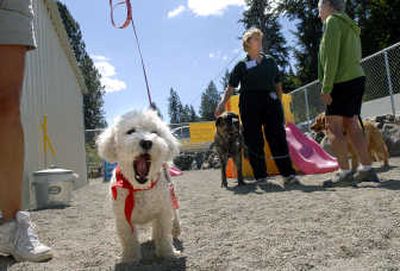Dogs trained to be friends in need

Puppy love takes on a new meaning this weekend. The 17 dogs scampering through the Spokane airport metal detector or perched at the neighboring restaurant table are not spoiled pets; they’re trained therapists participating in the city’s first crisis-response training workshop for animals.
The three-day session is sponsored by a local branch of the national nonprofit HOPE Animal-Assisted Crisis Response. It’s intended to teach dogs and their owners how to provide comfort to victims and responders in crises from school shootings to wildfires.
“The human-animal bond just helps,” said Debbie Wing, 49, who spearheaded the effort to create a Spokane branch a year ago. “It lowers blood pressure, decreases stress. You go home and hug your dog and feel better. Well, we provide comfort to those who can’t go home.”
Trained HOPE dogs have offered services after the Sept. 11 attacks, Hurricane Katrina and wildfires in San Bernardino, Calif. Sometimes they’re called in when a child who’s been beaten waits for child protective services or a police department deals with the death of an officer.
The service began in Oregon in 1998 following a fatal high school shooting.
Participants say they want the workshop to bring attention to the new program here. So far the community has yet to utilize it.
“Now we need to get into the system,” said Karen Hathaway, 64, holding onto her black collie, Raven. “It doesn’t have to be a disaster, just a small crisis.” On principle, the volunteer organization only responds when authorities ask.
The all-day training began Friday with a panel from the Spokane County Sheriff’s Office, Spokane police and fire departments and the Red Cross to “tell us how they can be used and how we could use them,” said Hathaway.
A mental health worker spoke Friday; today the dogs will experience a variety of scenarios such as boarding an airplane or going to a restaurant, necessary actions when on the road. They will also become familiar with hazardous material gear, fire hoses, ambulance sirens and other sights and sounds possible in crisis situations.
The dogs even will undergo “bootee practice,” said Wing, where special boots are affixed to their feet. This training not only prepares the dogs, it also helps assess how they will respond to stress. While most dogs gain certification at an awards ceremony on Sunday, it’s not a given, she said.
Wing, who heard about HOPE at a conference three years ago, came back to Spokane with the desire to establish a program here. As the owner of Lynn Dee’s Training Center, she already had a venue for it. Along with four others, she organized the workshop and drew people from as far away as Kansas City and Colorado.
The 18 teams had to undergo a screening process before they were allowed to participate. All dogs had to be registered through an animal assisted therapy program and have made at least 12 visits to hospitals, hospices or trauma locations.
But judging from the array of breeds present, the kind of dog does not matter. Nancy Royse, 59, one of the organizers, said mentality rather than size determines a dog’s ability to do this work.
“To be a HOPE dog you have to be able to manage unpredictable, stressful situations – to fly airplanes, ride buses. It takes a special animal to connect with people and deal with sirens, gunshots and crazy conditions,” she said.
And the dogs have to be able to deal with one another.
“There was a little ‘get off my tail’ kind of thing” at the opening of the session, said Mary Ann Hewicker, 43, a crisis mental health worker who flew from Denver for the training. “But they wouldn’t be here if they were not like this, all lovey-dovey, big and small,” she said, looking down at Stanley-Beaux, her huggable, beefy Bernese mountain dog.
“They bridge the gap between humans and trauma,” she said. “It’s their overall presence, their being, those puppy eyes, that puppy face. It gives people the ability to breathe. It’s a big self-soother.”